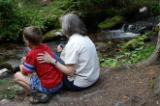Not All Places Are Equal
Whether your organization has an interest in protecting biodiversity or other recreational, historic, scenic, or cultural values, you must first consider where to concentrate conservation activities. This decision is made easier by the fact that high-priority features and resources are not found everywhere.
A fundamental lesson from biogeography is that biodiversity is not distributed uniformly or randomly across a landscape or across the globe – rather, no matter what spatial scale we choose, biodiversity is concentrated in particular areas. In the world of biodiversity conservation planning, such areas are often called “hot spots.” The same concentration of high-value features can be found for other resources; not all landscapes, for example, are equally scenic or suitable for recreation. Open space planners concerned with quality of life issues and dispersed recreation potential, for instance, would be particularly interested in protecting areas of high scenic value.
With the availability of comprehensive physical and biological databases, geographic information systems (GIS), satellite imagery, aerial photographs (e.g., Google Earth), and other spatial data, the process of identifying and mapping sites with concentrations of resources of interest has become much easier. Nevertheless, the ease of viewing and manipulating these datasets and maps carries a danger: the illusion that they are complete and accurate. For some features, the assumption that their coverage is comprehensive is mistaken because they rely on field work that is highly biased toward easily accessible sites, like those near roads. Rare-species occurrence data are usually quite incomplete; they record presences but not absences and reflect a bias against less accessible areas and private lands whose owners have not allowed access for surveys. In such cases, species-habitat models can be useful to extrapolate beyond known occurrences to other areas of suitable habitat (see examples here, here, and here).
Even with incomplete data, steering conservation efforts toward known or modeled areas of high value makes sense. At the same time, we must acknowledge mapping errors (both of omission and commission) and the uncertainty of model predictions. Thus, conservation planning should be an iterative process that is updated regularly as new data become available and as potential conservation areas are acquired, change ownership, or are lost to development.
Prioritization is the best way to make cost-efficient progress toward goals most– that is, to get the most bang for your buck. Sites can vary tremendously in acquisition or opportunity costs (Naidoo et al. 2006), but they may vary even more in the benefits (i.e., conservation or other values) they provide. Obtaining more data is key to cost-efficient prioritization; the cost of obtaining more information about sites, for example, through additional biological surveys, is minimal compared to the costs of protecting sites. In general, when costs of sites are more variable than site quality, then costs should drive the prioritization (site selection) process. In the opposite case, when site quality is more variable than costs, site quality is more important in prioritization (Perhans et al. 2008).
Prioritization can also be adjusted to schedule conservation actions that demonstrate progress toward goals and prudent and strategic use of resources (i.e., accountability to funders and the public). As a general rule, to ensure objective and accountable decision-making processes, prioritization should be systematic and science-based while employing the strategy of “informed opportunism” (Knight and Cowling 2008, Pressey and Bottrill 2008), where planners take advantages of good opportunities, such as a bargain sale of a large property, but then assess the consequences of such actions within a broader context and analyze potential trade-offs with other actions.
A Brief History of Conservation Planning
Go Straight to Your State
Learn about conservation and open space in your state.


